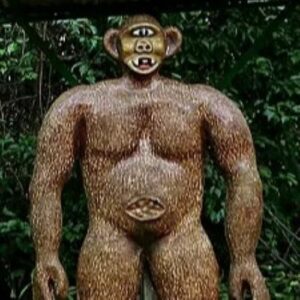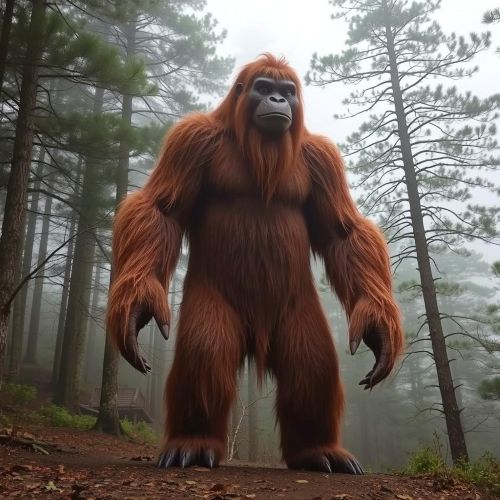Mapinguari : The Brazilian Bigfoot
| Description | |
|---|---|
| Origin | Brazil |
| Classification | Cryptid |
| Demeanour | Neutral |
| Habitat | Rainforests |
| Status | Not Proved |

Introduction
Deep within the heart of the Amazon rainforest, where sunlight barely penetrates the dense canopy, stories swirl about a fearsome creature known as the Mapinguari. Rooted in Brazilian folklore, the Mapinguari has long captured the imaginations of indigenous tribes, explorers, and cryptozoologists. More than just a mythical being, the Mapinguari represents both the mystique of the natural world and a possible connection to long-extinct creatures. Some believe it was once a shaman who achieved immortality, while others think it’s a relic of prehistory—a surviving giant ground sloth hidden in the unexplored depths of the jungle.
Physical Attributes
The Mapinguari is described in various ways, depending on the storyteller and the region, but certain physical features are consistently mentioned. Most depictions describe a large, upright creature covered in reddish-brown fur, towering up to six feet or more. The animal is often portrayed with a distorted face resembling that of a primate, sometimes with human-like traits, but always unsettling. Perhaps the most bizarre and terrifying characteristic is the second mouth located on its stomach, a grotesque feature said to emit terrifying sounds.
In other accounts, the creature has clawed limbs, backward-facing feet, and even crocodile-like skin—an amalgam of forest animals that emphasizes its unnatural essence. Its odor is also a crucial detail in most versions, with the beast releasing a putrid stench that paralyzes or repels intruders. Whether it’s a supernatural being or a surviving prehistoric mammal, its physical presence is said to be both overpowering and unforgettable.
First Sighting/Reporting
Tales of the Mapinguari have circulated among Amazonian tribes for centuries, passed down through oral tradition. However, the creature came to broader attention in the late 20th century thanks to David C. Oren, a biologist and ornithologist who compiled multiple eyewitness accounts. His research suggested that the creature might be a living descendant of the long-extinct giant ground sloth, Megatherium.
One particularly notable report came from a gold miner who claimed a direct encounter, describing a beast with a foul smell and long fur. Oren’s interest intensified after visiting the Karitiana reservation, where he heard of a cave associated with the creature. Locals described eerie sounds and recounted how entire communities had abandoned areas due to the presence of the Mapinguari. While scientific proof remains elusive, the frequency and consistency of reports continue to intrigue researchers and folklore enthusiasts alike.
Other Names
While most commonly referred to as the Mapinguari, the creature goes by several other names across regions and languages. In Brazilian Portuguese, “Mapinguary” is a widely used variant, often pronounced with a slight regional twist. Some indigenous communities call it “Isnashi,” while others refer to it as “Juma.” These names often reflect localized traditions and linguistic variations but generally point to the same forest-dwelling beast.
The name Mapinguari is often translated to mean “roaring animal” or “fetid beast,” capturing both its fearsome vocalizations and its unbearable smell. In some parts of the Amazon, the term “Mapinguari” has become a catch-all phrase for mysterious forest monsters, signifying the creature’s wide cultural reach and evolving identity.
Modus Operandi
More than a monster, the Mapinguari is portrayed as a sentinel of the rainforest—defending its domain against exploitation and disrespect. It is said to be fiercely territorial and nocturnal, often attacking intruders or those who desecrate the forest. The creature emits a thunderous cry and a stench so pungent that it renders victims unconscious or disoriented.
According to many tribal accounts, the Mapinguari is not just one creature but a species that lives in isolated groups deep in the jungle. Some say it appears only during certain times of the year or in areas where the forest has been particularly disturbed. Legends tell of the creature smashing machinery, chasing hunters, and disappearing without a trace. Its actions suggest a deep, almost spiritual connection to the land, often interpreted as a warning from nature itself.
Pop Culture References
Though less globally recognized than cryptids like Bigfoot or the Loch Ness Monster, the Mapinguari has carved out a space in South American pop culture. Its myth has inspired a range of media, from animated films to environmental literature. The 2020 animated movie The Red Scroll features a climactic scene where a character transforms into a Mapinguari, symbolizing both danger and transformation.
In the realm of literature, Riders of the Mapinguari by Gaddy Bergmann imagines a future world where the creature plays a central role in humanity’s survival. The comic Sheena: Trail of the Mapinguari weaves the legend into a murder mystery, while children’s books like Cléo and the Mapinguari bring the creature to younger audiences with messages about conservation and respect for nature. Educational works, such as those focusing on sustainable development, also feature the Mapinguari as a mascot for environmental stewardship.
Current Status
Despite numerous alleged sightings and extensive folklore, no scientific evidence of the Mapinguari’s existence has ever been produced. Skeptics argue that the creature is either a cultural metaphor or a case of mistaken identity—possibly large anteaters, bears, or even sloths seen under unusual circumstances. Still, cryptozoologists and some indigenous elders insist that the creature is real and should not be dismissed so easily.
The Mapinguari’s legend continues to be a vital part of Amazonian tribal traditions. Some communities still avoid certain forested regions out of respect—or fear—for the creature. Their stories maintain a consistent description, lending credibility to the theory that they are recalling memories of extinct megafauna passed down through generations.
Whether real or imagined, the Mapinguari remains a powerful symbol of the jungle’s untamed mystery. It serves as a reminder of the fragile balance between humanity and nature, and the possibility that not everything in our world has been discovered—or understood. As long as the Amazon endures, so too will the legend of the Mapinguari, lurking in the shadows of its green cathedral, watching, waiting, and warning.
Source
Barnes & Noble. (n.d.). Sheena: Trail of the Mapinguari (Comic Book)|eBook. Retrieved from https://www.barnesandnoble.com/w/sheena-steven-desouza/1104299269
Cryptozoological Reference Library. (2019, October). Did ground sloths survive to Recent times in the Amazon region? Retrieved from https://cryptozoologicalreferencelibrary.wordpress.com/wp-content/uploads/2019/10/oren-1993.pdf
Duaik. (2024, April 9). Legend or Reality? The Fascinating Story of the Mapinguari. Retrieved from https://www.duaik.com/en/news/posts/mapinguari
Fandom. (n.d.). Mapinguari | Cryptid Wiki. Retrieved from https://cryptidz.fandom.com/wiki/Mapinguari
Fandom. (n.d.). Mapinguari | Encyclopaedia of Cryptozoology. Retrieved from https://cryptidarchives.fandom.com/wiki/Mapinguari
Fandom. (n.d.). Mapinguari | Myth and Folklore Wiki. Retrieved from https://mythus.fandom.com/wiki/Mapinguari
Hernandez, J. A. (2023, October 10). Mapinguari of Brazilian Folklore | Into Horror History. Retrieved from https://www.jahernandez.com/posts/mapinguari-of-brazilian-folklore
Indigo. (n.d.). Cléo And The Mapinguari Book By Saulo Ribas, (‘eb’). Retrieved from https://www.indigo.ca/en-ca/cleo-and-the-mapinguari/0b335133-db2c-30d4-87c7-18b7bdc6e92c.html
Legends of Windemere. (2023, October 4). Monster Month: The Mapinguari. Retrieved from https://legendsofwindemere.com/2023/10/04/monster-month-the-mapinguari/
Occult World. (2021, July 1). Mapinguari. Retrieved from https://occult-world.com/mapinguari/
OntoSight. (n.d.). Mapinguari Sightings and Encounters: A Cryptid Exploration. Retrieved from https://ontosight.ai/library/article/mapinguari-sightings-and-encounters-a-cryptid-exploration–6827eb1ffb6076d4a3506008
PBS. (2022, June 7). Monstrum | Mapinguari: Fearsome Beast and Protector of the Amazon. Retrieved from https://www.pbs.org/video/mapinguari-fearsome-beast-and-protector-of-the-amazon-xnse9d/
The Cryptid Atlas. (2022, September 22). Mapinguari – South America Bigfoot, Cryptid Sloth, or Rainforest …. Retrieved from https://thecryptidatlas.com/mapinguari-south-america-bigfoot-cryptid-sloth-or-rainforest-guard/
Wikiwand. (n.d.). Mapinguari. Retrieved from https://www.wikiwand.com/en/articles/Mapinguari
Wikipedia. (n.d.). Mapinguari. Retrieved from https://en.wikipedia.org/wiki/Mapinguari









